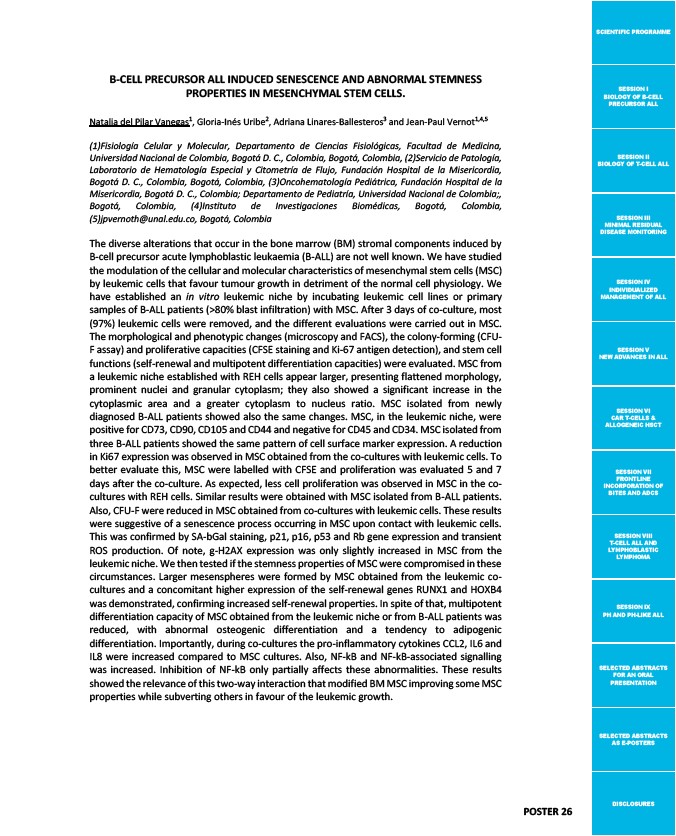
SCIENTIFIC PROGRAMME
SESSION I
BIOLOGY OF B-CELL
PRECURSOR ALL
SESSION II
BIOLOGY OF T-CELL ALL
SESSION III
MINIMAL RESIDUAL
DISEASE MONITORING
SESSION IV
INDIVIDUALIZED
MANAGEMENT OF ALL
SESSION V
NEW ADVANCES IN ALL
SESSION VI
CAR T-CELLS &
ALLOGENEIC HSCT
SESSION VII
FRONTLINE
INCORPORATION OF
BITES AND ADCS
SESSION VIII
T-CELL ALL AND
LYMPHOBLASTIC
LYMPHOMA
SESSION IX
PH AND PH-LIKE ALL
SELECTED ABSTRACTS
FOR AN ORAL
PRESENTATION
SELECTED ABSTRACTS
AS E-POSTERS
DISCLOSURES
B-CELL PRECURSOR ALL INDUCED SENESCENCE AND ABNORMAL STEMNESS
PROPERTIES IN MESENCHYMAL STEM CELLS.
Natalia del Pilar Vanegas1, Gloria-Inés Uribe2, Adriana Linares-Ballesteros3 and Jean-Paul Vernot1,4,5
(1)Fisiología Celular y Molecular, Departamento de Ciencias Fisiológicas, Facultad de Medicina,
Universidad Nacional de Colombia, Bogotá D. C., Colombia, Bogotá, Colombia, (2)Servicio de Patología,
Laboratorio de Hematología Especial y Citometría de Flujo, Fundación Hospital de la Misericordia,
Bogotá D. C., Colombia, Bogotá, Colombia, (3)Oncohematología Pediátrica, Fundación Hospital de la
Misericordia, Bogotá D. C., Colombia; Departamento de Pediatría, Universidad Nacional de Colombia;,
Bogotá, Colombia, (4)Instituto de Investigaciones Biomédicas, Bogotá, Colombia,
(5)jpvernoth@unal.edu.co, Bogotá, Colombia
The diverse alterations that occur in the bone marrow (BM) stromal components induced by
B-cell precursor acute lymphoblastic leukaemia (B-ALL) are not well known. We have studied
the modulation of the cellular and molecular characteristics of mesenchymal stem cells (MSC)
by leukemic cells that favour tumour growth in detriment of the normal cell physiology. We
have established an in vitro leukemic niche by incubating leukemic cell lines or primary
samples of B-ALL patients (>80% blast infiltration) with MSC. After 3 days of co-culture, most
(97%) leukemic cells were removed, and the different evaluations were carried out in MSC.
The morphological and phenotypic changes (microscopy and FACS), the colony-forming (CFU-F
assay) and proliferative capacities (CFSE staining and Ki-67 antigen detection), and stem cell
functions (self-renewal and multipotent differentiation capacities) were evaluated. MSC from
a leukemic niche established with REH cells appear larger, presenting flattened morphology,
prominent nuclei and granular cytoplasm; they also showed a significant increase in the
cytoplasmic area and a greater cytoplasm to nucleus ratio. MSC isolated from newly
diagnosed B-ALL patients showed also the same changes. MSC, in the leukemic niche, were
positive for CD73, CD90, CD105 and CD44 and negative for CD45 and CD34. MSC isolated from
three B-ALL patients showed the same pattern of cell surface marker expression. A reduction
in Ki67 expression was observed in MSC obtained from the co-cultures with leukemic cells. To
better evaluate this, MSC were labelled with CFSE and proliferation was evaluated 5 and 7
days after the co-culture. As expected, less cell proliferation was observed in MSC in the co-cultures
with REH cells. Similar results were obtained with MSC isolated from B-ALL patients.
Also, CFU-F were reduced in MSC obtained from co-cultures with leukemic cells. These results
were suggestive of a senescence process occurring in MSC upon contact with leukemic cells.
This was confirmed by SA-bGal staining, p21, p16, p53 and Rb gene expression and transient
ROS production. Of note, g-H2AX expression was only slightly increased in MSC from the
leukemic niche. We then tested if the stemness properties of MSC were compromised in these
circumstances. Larger mesenspheres were formed by MSC obtained from the leukemic co-cultures
and a concomitant higher expression of the self-renewal genes RUNX1 and HOXB4
was demonstrated, confirming increased self-renewal properties. In spite of that, multipotent
differentiation capacity of MSC obtained from the leukemic niche or from B-ALL patients was
reduced, with abnormal osteogenic differentiation and a tendency to adipogenic
differentiation. Importantly, during co-cultures the pro-inflammatory cytokines CCL2, IL6 and
IL8 were increased compared to MSC cultures. Also, NF-kB and NF-kB-associated signalling
was increased. Inhibition of NF-kB only partially affects these abnormalities. These results
showed the relevance of this two-way interaction that modified BM MSC improving some MSC
properties while subverting others in favour of the leukemic growth.
POSTER 26